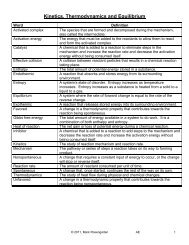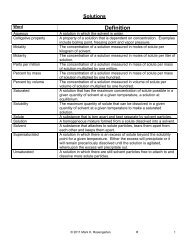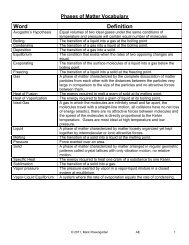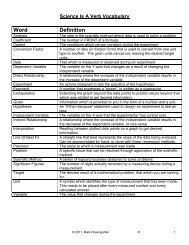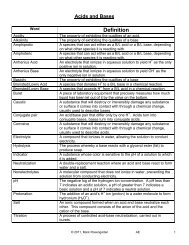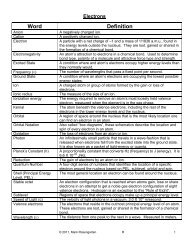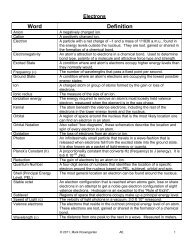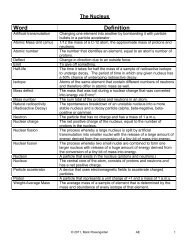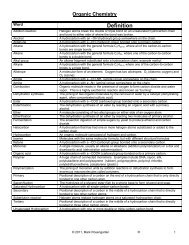Unit 4 - Mark Rosengarten
Unit 4 - Mark Rosengarten
Unit 4 - Mark Rosengarten
Create successful ePaper yourself
Turn your PDF publications into a flip-book with our unique Google optimized e-Paper software.
1) Atomic Structure (The Nucleus) (HW: p. 19, 20)<br />
Essential Question: What is everything made up of?<br />
Atoms are the smallest pieces an element can be broken into and still retain the properties of that element. It comes<br />
from the Greek word atomos, meaning “indivisible” (unbreakable).<br />
Atoms are so tiny that they can not be seen directly. They can be detected through X-ray crystallography or atomic<br />
force microscopes, but only indirectly.<br />
It takes 602 000 000 000 000 000 000 000 atoms of hydrogen to weigh 1 gram (the mass of a small paper clip).<br />
Atoms are made up of the following particles:<br />
A) Nucleons (Particles in the Nucleus)<br />
1) Protons: have a mass of 1 atomic mass unit (1.66 X 10 -24 grams) and a charge of +1. They are found in the<br />
nucleus of the atom, and the number of protons in the atom is the atomic number, which identifies what element the<br />
atom is. Oxygen (O) has an atomic number of 8, which means there are 8 protons in the nucleus. Since protons are<br />
the only particle in the nucleus to have a charge, the charge of the nucleus is + (# of protons). Since oxygen has 8<br />
protons in the nucleus, oxygen has a nuclear charge of +8. We will use nuclear charge down the road for the<br />
purposes of explaining why it is easier to do nuclear fusion with smaller nuclei and why atoms have the sizes they do.<br />
2) Neutrons: have a mass of 1 atomic mass unit, and no charge. They are found in the nucleus of the atom, and the<br />
number of neutrons added to the number of protons gives you the mass number of the atom. The number of neutrons<br />
does not affect the identity of the element. Oxygen’s most common form has a mass number of 16. Since there are 8<br />
protons in the nucleus of oxygen, this means there must also be 8 neutrons to give a combined mass of 16. The<br />
number of protons and neutrons does NOT have to be equal. In addition, atoms of any given element can have<br />
differing numbers of neutrons. Atoms of the same element with different numbers of neutrons in their nuclei are called<br />
ISOTOPES of one another. The most common isotope is the one who’s mass equals the average atomic mass given<br />
on the periodic table rounded to the nearest whole number. Since O has a given average mass of 15.9994, the most<br />
common isotope of O is O-16, or Oxygen with a mass number of 16. See the diagram below.<br />
B) Particles Outside The Nucleus<br />
3) Electrons: have a mass of 1/1836 amu (9.11×10 −28 grams) and a charge of -1. They are found orbiting the nucleus<br />
in energy levels. Atoms gain, lose or share electrons when they form chemical bonds. If electrons are gained and<br />
lost, an ionic bond is formed. If electrons are shared, a covalent bond is formed. The number of electrons in the atom<br />
equals the number of protons. Atoms are neutrally charged, so the + charged protons and the – charged electrons<br />
must be equal in number to give a neutral charge. Oxygen has 8 protons in its nucleus, so there must be 8 electrons<br />
zipping around outside the nucleus in energy levels. In this unit, the only thing you need to worry about is how to find<br />
out how many electrons an atom has, and what the charge and mass of an electron are. Later in the course, you will<br />
see just how important electrons are to all of chemistry. They are the part of the atom responsible for all chemical<br />
bonding. If it weren’t for electrons, there would be no compounds. H would not bond to O, and water would not exist!<br />
© 2011, <strong>Mark</strong> <strong>Rosengarten</strong> R 2



